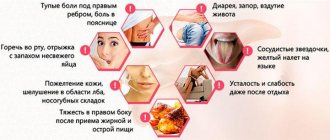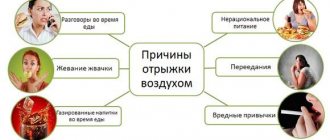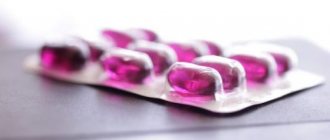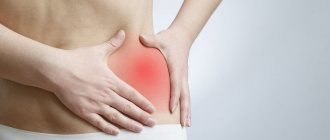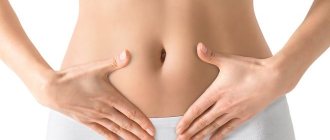Pain in the right side, accompanied by nausea and vomiting, are signs of various diseases that cannot be ignored. Suppressing unpleasant symptoms by taking painkillers is not the best solution. Analgesics are not able to cure the underlying disease, but only eliminate its manifestations, so it will not be possible to do without medical help.
If your right side hurts and feels nauseous for the first time, you probably just overate, overloading your body. Try taking Mezim, but if the situation repeats, do not ignore it. Now we will try to understand in detail why the right side hurts, nausea, dizziness and other symptoms.
- Right side hurts: inflammation of the pancreas
- Pain in the right side due to appendicitis
- Pain in the right side with liver diseases
- Gallbladder diseases
- When is hospitalization necessary?
Pain and nausea in the right side
Nausea and pain in the right side cause significant discomfort and impair performance, but they act as a protector of the integrity of the body and will be an important biological factor that ensures the preservation of life.
Therefore, you should not drown out painful sensations, if they are in the hypochondrium or lower abdominal cavity, with anesthetic drugs without the recommendation of a specialist and until the factors that provoked their occurrence are clarified.
Pain in the right side in the hypochondrium is dangerous because vital organs are located in that place: liver, gall bladder, pancreas, kidney.
The health risk increases when nausea occurs, and pain in the right hypochondrium or lower abdominal cavity is associated with disruption of the stomach. If your right side hurts and you feel nauseous, you should pay attention to other symptoms.
What should I do?
When the first alarming symptoms appear, you should seek help from a doctor as soon as possible.
After the initial examination, the therapist may refer the patient to:
- gastroenterologist;
- nephrologist;
- surgeon;
- cardiologist;
- vertebrologist;
- traumatologist
The table presents methods of primary diagnosis.
Table 4. What does the doctor do first?
| Doctor's action | Description |
| This helps to identify the root cause. |
| The method is necessary to confirm or refute exposure to non-hazardous sources. |
| The specialist assesses the condition of the skin, sclera, and mucous membranes. Then the doctor carefully palpates the anterior wall of the peritoneum. |
| Temperature and heart rate indicators are also measured. |
Auxiliary diagnostic methods are presented in the table.
Table 5. Features of secondary diagnostics.
| Laboratory research | Instrumental diagnostics |
| PCR and hormonal testing, liver tests, stool examination under a microscope, biochemical blood test, general clinical blood and urine tests. | Ultrasound examination of the abdominal organs, MRI, CT, ECG, endoscopy. Gastroscopy is also performed. If necessary, the patient undergoes a biopsy. |
You can relieve discomfort without medications using a compress
The instructions look like this:
- Take a horizontal position and try to calm down.
- If a feeling of fullness in the right hypochondrium is accompanied by swelling in this area, vomiting and severe pain, you should call an ambulance as soon as possible. This symptom may indicate inflammation of the appendix.
- If a feeling of heaviness in the right hypochondrium is accompanied by aching pain, you can place a compress on the sore area. It is recommended to apply a cold towel or ice pack.
- If the pain does not disappear, you can take 1 tablet of No-shpa. This drug is not recommended for those with hypersensitivity to sodium metabisulfite.
- You can relieve severe pain with a glass of heavy cream. The liquid flows around the gastric walls, preventing the acidic secretion from irritating its surface.
The tablet describes the features of drug therapy.
Table 6. Drug treatment.
| Pathology | What medications are prescribed? |
| Antiviral drugs, detoxifying drugs, anticholestatics, glucocorticosteroids, hepatoprotectors. |
| Analgesics, anti-inflammatory drugs, chondroprotectors. |
| Beta-blockers, antiplatelet agents, vasodilators. |
In case of acute pancreatitis, urgent surgery is prescribed. The cost of delay can be very high.
Symptoms
In situations where providing care and therapy at home poses a threat to the patient and loved ones, the patient should be hospitalized.
This may be caused by the following factors:
- temperature of approximately 40 degrees or more, associated with delirium, severe headache;
- lethargy occurs, the patient drinks a large amount of liquid, dry skin develops, the cheeks begin to fall in, and facial features become sharpened;
- constant urge to defecate, up to 10 times a day, diarrhea;
- unusually colored liquid feces with green-yellow impurities and blood streaks;
- dark vomit;
- yellowness of the eyes and skin;
- intense chills followed by high fever;
- sharp, stabbing pain in the hypochondrium.
Major diseases
There are a large number of diseases that can cause such unpleasant symptoms.
To establish the specific causes that provoked the disease, it is necessary to consult with a specialist regarding diagnostics and the choice of appropriate therapy.
The inflammatory process of the appendix is called appendicitis. Usually the organ is located below the liver and has a small cavity that opens into the cecum, thanks to a small flap valve.
The provoking factor of the disease is considered to be saprophytes, which exhibit their pathogenic characteristics under favorable conditions.
The disease is promoted by clogging of the appendix with feces, which occurs during constipation. There are acute and chronic forms of the disease:
In acute appendicitis, pain occurs in the right side in the lower abdominal cavity.
The pain tends to increase, intensify during coughing, in the process of changing the position of the body, is associated with nausea, a gag reflex, and diarrhea is observed.
The side hurts so much that sticky sweat appears, and the temperature increases significantly. The examination is carried out by palpation.
If symptoms of appendicitis occur, the patient should be placed on the bed, cold water or ice placed on the right side and doctors should be called immediately.
The patient must be hospitalized, and assistance will be provided surgically.
Otherwise, the walls of the appendix are destroyed, pus penetrates into the abdomen, which is a provoking factor for peritonitis, characterized by extremely difficult general health of the patient.
How to eliminate pain?
It is advisable to take any medications only after consultation with a specialist. Before taking a painkiller, you need to remember that such help can affect the establishment of an accurate diagnosis, so you should not abuse self-medication.
- The recommended medicine for acute pain is No-Shpu (Drotaverine), a relatively safe antispasmodic that can quickly improve the patient’s condition. But you can take it without seeking emergency help only as a last resort.
- Traditional methods will help with an ice compress applied to the location of the unpleasant manifestation. The hot form of this assistance will have to be abandoned - an increase in temperature can provoke a deterioration in the patient’s condition, rupture of an abscess or appendix, which can lead to death.
Caution should be exercised with young patients. Children cannot always accurately and intelligibly describe the sensations they experience, so taking action on their own is prohibited; only calling an ambulance is permissible.
Hepatitis A
Acute infectious disease. Virus A can be transmitted through contaminated food and water, the fecal-oral route, and poor sanitation.
The disease is dangerous because it is viral in nature and the sick person can infect others.
The pathogen will be resistant to elevated temperatures, persists for up to 3-5 months in water, the incubation period lasts from 15 days to 2 months.
Symptoms of the disease:
- general malaise, which is accompanied by slight chills;
- nausea and disturbances in the functioning of the stomach, diarrhea;
- loss of appetite;
- in the oral cavity after a meal there is the formation of a bitter salty taste and belching;
- there is pain in muscles and joints;
- a significant increase in temperature up to 40 degrees;
- formation of painful sensations in the hypochondrium in the right side and in the lower part of the abdominal cavity.
As the disease intensifies, the skin becomes yellow, the whites of the eyes also turn yellow, the urine becomes dark, the feces gray-white, and the painful discomfort in the hypochondrium becomes stronger.
Pain can be observed near the back and in the lower abdomen.
Diagnosis of the disease is carried out by examining blood, urine and stool in a laboratory setting. Therapy must take place in a hospital.
The duration of treatment varies depending on the severity of the disease. Timely therapy and following all medical instructions give positive results.
In order to restore liver function, it is possible to use a folk remedy using oats. For half a glass of oats, take 0.5 liters of water, infuse for 14 days under a closed lid with little access to oxygen.
After this period, the lid should be screwed on tightly. The product is placed on low heat for 30 minutes, then removed from the heat and placed in a place inaccessible to sunlight for 12 hours.
Next, the finished mass is filtered through cheesecloth and water is added so that a volume of 0.6 liters is formed. Should be taken three times a day before meals, 30 minutes.
Gallbladder problems
Most often, the only treatment method is surgery. The operation is reduced to either removing stones or the gallbladder, depending on the stage of the disease.
In mild cases of cholecystitis, you can get by by taking antispasmodics to relieve pain. Antibiotics are also prescribed to combat the microbial environment.
Therapeutic diet
The patient must adhere to a strict diet without foods that provoke the release of bile. Useful for gallbladder disease:
- Fermented milk products with low fat content;
- Vegetables and fruits containing coarse fiber;
- Boiled lean fish, meat, poultry;
- Compotes and jelly;
- Vegetable soups;
- Cereals.
Traditional methods are also used in the treatment of the gallbladder. But only after consultation with your doctor. To cleanse the gallbladder, methods based on the use of olive oil, black radish, egg yolks, and lemon juice are used. Rosehip infusion is useful.
First, let's look at the symptoms of gallstones. Gallstone disease develops as a result of the formation of stones in the bladder, which are formed from hard pieces of bile.
Symptoms of organ dysfunction are sharp pain in the hypochondrium due to the advancement of the stone into the bile duct, as well as nausea and a bitter taste in the mouth.
The right side of the abdomen also hurts with cholecystitis - blockage of the ducts that remove bile. In this case, inflammation is caused by viruses, parasites or bacteria.
The organ contracts frequently and strongly, so a person feels a sharp, short-term pain under the ribs, which in most cases bothers you at night. Causes of blockage of the bile ducts also include injuries, severe stress, and nervous strain.
READ MORE: Left side hurts from below
Fever, unbearable pain radiating to the right rib, shoulder or shoulder blade are characteristic of acute cholecystitis. This condition is very dangerous as it leads to peritonitis. You should immediately consult a doctor.
Therapeutic diet
Hepatitis B
This form of hepatitis differs from A in the greater severity of its course, since various kinds of adverse consequences are formed. The risk of infection will not disappear at high or low temperatures.
Infection can occur through sexual contact, domestic and artificial. The viral agent is found in saliva, urine, semen, vaginal secretions, and blood during menstruation.
In domestic conditions, infection occurs through the use of shared toothbrushes, towels and other personal hygiene items.
Infection can occur if the integrity of the patient’s skin is compromised: scratches, open injuries, inflammatory processes of the skin, burns, infection during childbirth.
People who use drugs are also susceptible to the disease.
The general symptoms of the disease are:
- cough and rhinitis;
- belching and nausea, fever up to 40 degrees;
- yellowness of the skin and whites of the eyes;
- change in urine color;
- dizziness;
- itching and rash over the entire surface of the body;
- pain in the right side of a pulling nature;
- diarrhea.
The disease is characterized by a transition from acute to chronic form, which in the future provokes cirrhosis of the liver.
Patients undergo drug therapy in an inpatient setting. The therapeutic course is aimed at removing toxins, correcting damaged liver function and extrahepatic manifestations.
When the disease passes with severe adverse consequences - diarrhea and a gag reflex occur, pain in the hypochondrium and in the lower part of the abdominal cavity, during which the patient significantly loses body weight and vomits.
In this situation, special therapy is used, which is aimed at replenishing fluid volume.
If a severe form of the disease is observed, swelling in the brain and liver encephalopathy develop, manifested by mental disorders, consciousness, and inappropriate behavior.
Hepatitis C
There are no clinical signs of the disease observed for a long period of time. The patient accidentally finds out that he has hepatitis C during blood tests and during routine medical diagnostics.
The disease from people who are carriers of an active form of hepatitis C can be transmitted to healthy people during the onset of favorable conditions:
- 1 syringe is used by a large number of people who have drug addiction;
- tattooing on the surface of the body with non-compliance with sanitary conditions;
- hygiene items are used by several people in the process of living together;
- during a blood transfusion;
- during sexual intercourse;
- from the mother's placenta to the baby during childbirth.
When infected, the following symptoms are observed in 2-3 weeks:
- muscle and joint pain;
- high fatigue and malaise;
- disturbances in the digestive processes, belching, diarrhea, nausea;
- slight increase in temperature.
In order to detect such a viral agent, a clinical examination is carried out using serological and molecular biological diagnostic methods.
In certain situations, the immune system is able to suppress the pathogen. In this case, the patient does not need therapy, but this is observed quite rarely.
Most patients begin drug treatment, which lasts from 3 months to a year.
The acute form of hepatitis C becomes chronic in stages: over several years, the number of affected liver cells may increase, and fibrosis forms.
Liver function can persist for a long period of time.
Specific symptoms of the disease are yellowness of the skin, an increase in the volume of the abdomen, the appearance of spider veins on the dermis of the peritoneum, and the appearance of cirrhosis of the liver, which requires surgical intervention.
Pancreatitis
Among diseases of the pancreas, this is observed more often than others. There are acute and chronic forms of the disease. Pancreatitis is diagnosed by clinical methods, as well as through the following examination methods:
• Ultrasound, X-ray with HF; • radioisotope method; • gastroscopy; • colonoscopy; • esophagoscopy.
In the acute form of the disease, intense pain in the right hypochondrium is girdling in nature, manifests itself in the upper part of the abdominal cavity, in the side, and radiates to the back.
Discomfort is associated with nausea, a gag reflex, sticky sweat, increased pallor of the skin, and belching.
With severe symptoms of such pain, a state of shock occurs.
In such a situation, emergency assistance must be called, and until it arrives, the patient must put ice on the upper part of the peritoneum.
The provoking factors of the inflammatory process in the pancreas are:
- vascular lesion;
- viral diseases;
- injuries;
- inflammation in the abdominal cavity;
- the appearance of gallstones;
- excessive consumption of alcoholic beverages;
- unbalanced diet, overeating.
The acute form of pancreatitis is treated in an inpatient setting. The basis of therapy are:
- antimicrobial agents;
- drugs that suppress the enzymatic activity of this organ;
- strict dietary nutrition;
- bed rest.
In certain situations, surgical intervention is possible. The acute form of pancreatitis, if therapy is not started in a timely manner, can become chronic.
During an exacerbation of this form of the disease, the upper part of the abdominal cavity hurts, and the discomfort radiates to the back. Painful symptoms are not as severe as during acute pancreatitis.
Paired with:
- nausea and gag reflex;
- bloating and loss of appetite;
- belching and heartburn;
- feces are sometimes fatty and clayey in consistency.
Therapy for the chronic form of the disease is based on an individual approach to the patient. Strict adherence to medical instructions regarding a diet that excludes fatty foods and alcohol is necessary.
Anti-inflammatory drugs and tablets have proven themselves well in treating the disease: Papaverine hydrochloride, No-shpa. For anesthesia purposes: Atropine, Metacin, Chlorosil.
Do you still think that healing your stomach and intestines is difficult?
Most often, the only treatment method is surgery. The operation is reduced to either removing stones or the gallbladder, depending on the stage of the disease. In mild cases of cholecystitis, you can get by by taking antispasmodics to relieve pain.
Judging by the fact that you are now reading these lines, victory in the fight against diseases of the gastrointestinal tract is not yet on your side...
Have you already thought about surgery? This is understandable, because the stomach is a very important organ, and its proper functioning is the key to health and well-being. Frequent abdominal pain, heartburn, bloating, belching, nausea, bowel dysfunction... All these symptoms are familiar to you firsthand.
Since pain is a symptom, it is not the pain that needs to be treated, but the disease that provoked it. How often do we take analgesics or antispasmodics in any situation! And how often do surgeons or gynecologists then scold patients for not immediately seeking help? But it is easier to treat any disease at the very beginning, and not at the stage of development of serious complications.
In the treatment of the described diseases, all methods available to medicine are used:
- Diet therapy:
- refusal of fatty, fried, spicy foods - for gallbladder diseases;
- exclusion of coarse fiber, spices - for intestinal diseases;
- complete hunger for several days - with acute pancreatitis;
- Drug treatment:
- for inflammation in any area - antibiotics;
- for oncological diseases - radiation, chemotherapy and radiotherapy;
- for herpes zoster - antiviral drugs, the only effective ones for this pathology;
- antispasmodics and analgesics - just as an element of complex treatment;
- Surgical intervention is a last resort, and sometimes the only effective measure to combat pathology:
- appendicitis;
- torsion of the pedicle of an ovarian tumor;
- his apoplexy;
- ectopic pregnancy;
- cholelithiasis;
- some forms of Crohn's disease;
- tumors of the Vater's nipple.
Whatever the pain in the right side - constant or paroxysmal, stabbing, aching or pressing - it is a symptom of trouble in some organ. Ignoring it, taking analgesics and antispasmodics on your own is a sure way to a hospital bed, or even to a surgeon’s table.
Sometimes a person gets to the doctors too late and then all their efforts are in vain. Therefore, in case of any pain attack, even if it has passed, do not be lazy - at least contact your local physician. It’s better for him to grumble that you came to him in vain, rather than have a surgeon operate on you or open you up with a pathologist.
Bozbey Gennady, medical columnist, emergency doctor
The therapy is based on comprehensive measures aimed at eliminating the cause of the pathology, which manifests itself as unpleasant symptoms. Pharmacological drugs in combination with herbal remedies and diet provide a positive prognosis for recovery.
In some diseases of the digestive system, central nervous system disorders, intoxication with alcohol, food or drugs, vomiting of bile may occur. Also, this condition is often observed in women in early pregnancy during the period of toxicosis.
Vomiting is one of the ways the body self-cleanses harmful substances and, as a rule, after it a person’s condition improves. For effective treatment and prevention of recurrences of vomiting attacks in the future, it is important to accurately establish the cause (the basis, the pretext for some action.
For example: Good reason; Laugh for no reason; For the reason that..., for the reason that..., because of the fact that) (A reason, a pretext for some action. For example: Good reason; Laugh for no reason; For the reason that..., for the reason that..., because -for the fact that), which caused a gag reflex.
Quite often, the main factor that provokes the appearance of painful sensations is an unstable emotional state. In such cases, the patient does not require drug therapy, but psychological therapy. Depending on the results of the diagnosis, the doctor prescribes various medications.
Nonsteroidal anti-inflammatory drugs (NSAIDs, NSAIDs)
Taking into account the development of the pathology that provoked pain in the head and eye, the patient is prescribed different groups of drugs, for example, non-steroidal anti-inflammatory drugs (Nimesil, Ibuprofen), painkillers (Analgin, Aspirin, Nurofen, etc.). d.
On a note! Throughout the entire treatment course, as well as after surgery, doctors recommend maintaining a drinking regime. It is necessary to drink enough fluids and get plenty of rest. This will speed up the recovery processes in the body.
Device for physiotherapeutic effects "Darsonval"
- Intestinal diseases (gastritis, ulcers, colitis, etc.);
It is especially worth paying attention to pain in the left side of the abdomen in pregnant women. These may be physiological reasons (the fetus is attached to the left side of the uterus, which causes pain) or various pathological reasons (cystitis, spontaneous abortion, digestive disorders).
If you believe the statistics, more than 60% of people who were admitted with pain in the left side needed urgent medical care and transfer to an inpatient unit. The main thing is not to think that such pain can go away on its own and that the help of specialists is not needed.
Kidney failure
The human urinary system is represented by the kidneys, ureters, bladder, and urethra. A disorder in the functioning of any organ negatively affects the functioning of the body.
If you do not consult a specialist in a timely manner, in a situation of kidney disease, kidney failure develops.
This occurs due to the fact that toxic substances from protein metabolism accumulate inside the body. There are acute and chronic forms of the disease.
The acute form appears when there is a sharp deterioration in kidney function and when most of the kidney is affected. Provoking factors are:
- severe viral diseases;
- state of shock;
- vascular lesion;
Therapy consists of removing toxins from the body. To rid the body of nitrogenous waste, hemodialysis is used, during which the blood is purified through an artificial membrane using an “artificial kidney” apparatus.
Saline solutions are administered. Diuretics and antimicrobial agents are taken.
The chronic form of the disease develops in stages. During this, a gradual and inevitable death of kidney cells occurs. Due to the loss of the filtering surface by the organ, nitrogenous waste accumulates inside the body.
Stones in the kidneys
A disease of the urinary system, during which a conglomerate of the constituent elements of urine is formed. Urinary stones are a consequence of impaired metabolism and malfunction of the endocrine glands.
Symptoms:
- pain in the lower back in the hypochondrium;
- during urination the stream is interrupted;
- urine with blood impurities;
- burning during urination;
- nausea and gag reflex.
Manifestations of urolithiasis vary depending on the location of the stone. When it is in the kidneys, it provokes aching pain in the lumbar region, which intensifies during physical activity.
Stones that remain in the renal pelvis for a long time provoke its expansion, which is associated with inflammation. As a result, pain occurs in the right hypochondrium. It is associated with:
- nausea and gag reflex;
- cold sweating;
- bloating;
- elevated temperature.
During the treatment of urolithiasis, stones are eliminated, but the treatment method varies depending on the size and location of the foreign body.
Small stones are expelled from the kidneys and ureters through medications, physiotherapy, and drinking plenty of fluids under the supervision of a specialist.
In some situations, the stone is removed from the ureter with a special loop; when this is not possible, surgical intervention is used.
When to see a doctor
If the patient is bothered by persistent sharp pain in the right side of a pulling nature and nausea, hospitalization is necessary.
The following factors accompanying discomfort become the reason for calling doctors or immediate hospitalization:
- elevated temperature up to 40 degrees;
- severe pain and dizziness;
- general malaise, desire to drink large amounts of water, dry skin, hollow cheeks;
- diarrhea or frequent urges up to 10 times a day;
- liquid stool interspersed with green-yellow color;
- dark vomit;
- yellowness of the skin and whites of the eyes;
- severe chills and fever, alternating with each other.
In all situations, there is a high risk of adverse consequences, including death. Therefore, you should not delay visiting a doctor or calling an ambulance.
Pain in the right side and nausea are symptoms of various diseases that should not be ignored. It is not recommended to eliminate such unpleasant symptoms by using painkillers.
Analgesic drugs cannot cure the underlying disease, but only remove its manifestations, so you cannot do without the help of a specialist.
When a patient has pain in the right side for the first time and feels nauseous, it may be normal overeating and Mezim should be taken. However, when the situation repeats, you should consult a doctor.
Prevention
You can reduce the likelihood of diseases manifested by colic in the right hypochondrium and nausea if:
- follow the principles of proper nutrition;
- do not ignore hygiene standards;
- avoid stressful situations;
- to refuse from bad habits;
- maintain an active lifestyle.
An integral part of prevention is undergoing a medical examination (2 times a year) from specialized specialists (gastroenterologist, immunologist, endocrinologist, infectious disease specialist, nutritionist).
At the slightest manifestation of these symptoms, you should immediately contact a specialist. Untimely medical history, examination, diagnosis and delayed treatment can lead to serious health problems, including death.

